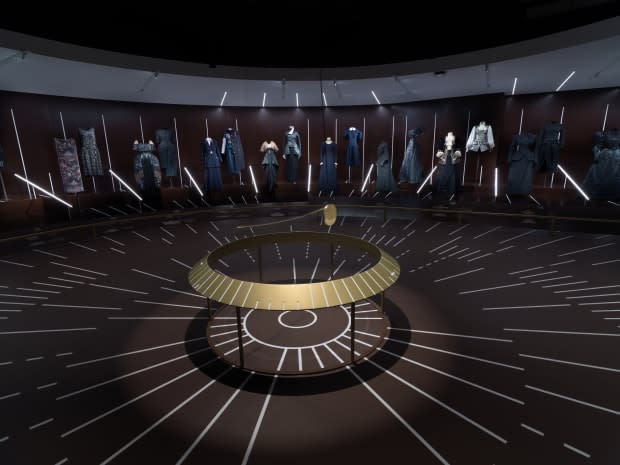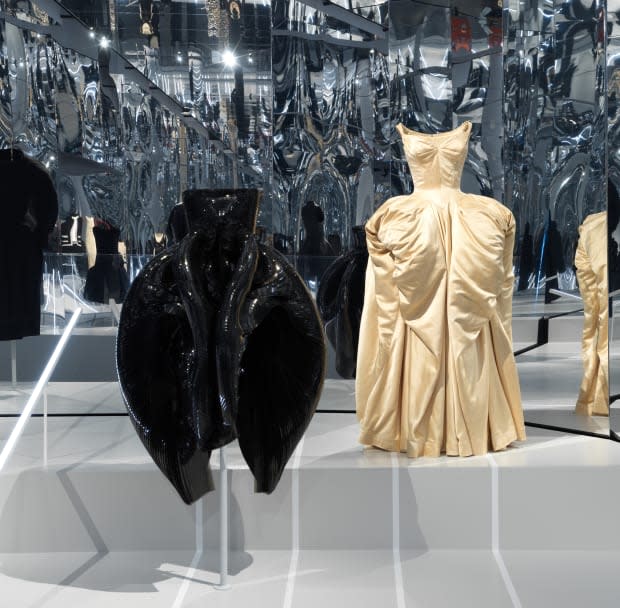The Costume Institute's 'About Time' Exhibition Subtly Points to Sustainability as the Future of Fashion
The latest from the Met invites viewers to reflect on fashion's relationship with the past, and also has some important things to say about where the industry is headed in the future.
If time used to march along in a straight line, progressing at regular intervals of minutes, days and years, that all seemed to change in 2020.
As the pandemic forced people to stay home, the routines we'd relied on in the past — like going into an office Monday through Friday — dissolved, leaving in their wake a population that could barely remember what day it was. Against that backdrop, the Metropolitan Museum of Art's new Costume Institute exhibition, "About Time," feels almost prescient.
"The show is a meditation on fashion and temporality," said curator Andrew Bolton in a series of virtual remarks on the day the exhibition opened. That meditation feels utterly relevant in a year that's seemed to distort and suspend time like never before. (Originally slated to open in May, "About Time" was postponed almost half a year and debuted in October without the fanfare usually generated by the Met Gala, which was cancelled this year.)
"Fashion is indelibly connected to time. It not only reflects and represents the spirit of the times, but it also changes and develops with the times, serving as an especially sensitive and accurate timepiece," Bolton added, in a press release. "Through a series of chronologies, the exhibition uses the concept of duration to analyze the temporal twists and turns of fashion history.”
"About Time" features garments from the past 150 years (starting from 1870, when the Met was founded) and mostly pulls garments from the museum's own collection. But it's far from a simple history lesson: The exhibition fills two rooms, each designed as enormous clock faces, with each "tick" of the clock containing two ensembles, almost all of which are black.

"It needs to be communicated that this is linear, consequential. One historical and social and political fact led to the next and therefore one form expanded and contracted to the next. But equally, there are strange folds in time," said exhibition designer Es Devlin.
To portray that linearity as well as those "folds," the two rooms of the exhibition are set up differently. In the first, the front row of outfits follows a strictly chronological timeline; each is paired with an outfit in the back row from another period in history that's aesthetically linked to the first, whether through construction, embellishments, silhouette or something else — think a ladylike 1947 Christian Dior outfit alongside a 2011 Junya Watanabe leather jacket and skirt that mimic the same shape. These juxtapositions help paint a picture both of how fashion has progressed over time, and how future generations and designers have mined the past to interpret their own futures.
But in the second room, that straightforward chronology starts to break down. The subdued, easy-to-understand black backdrop of the first space gives way to a disorienting set of mirrored and refracted walls in the second. The years start to jump forward and back without any sense of clear progression. It's an effective way of making the visitor feel, on a more visceral level, a truth that fashion historians have long chronicled: In the 21st century, fashion has left behind the world of clear visual codes that make it easy to distinguish '60s fashion from '20s fashion and instead has started to treat all of history as a grab-bag of influences, making for a much less unified landscape that's is constantly pulling from different decades.

The exhibition operates on two levels, one more accessible and one a bit more esoteric. In the former category, there's the visual experience of the exhibition itself, with the clock imagery and the garment pairings that invite viewers to guess at the aesthetic connections that bind them across the decades. There are beautiful garments that have been worn by famous people, like the Iris Van Herpen dress Solange Knowles wore to the 2018 Met Gala; iconic pieces like Versace's safety-pin gown; and pretty sparkly things from designers who have become celebrities in their own right, like Balmain's Olivier Rousteing. (Not to mention the appeal of the reflective walls in the second room, which are sure to inspire plenty of mirror selfies.)
On a more cerebral level, there are a plethora of philosophically challenging underpinnings, from Virginia Woolf's musings (some of which can be heard in voiceovers throughout that gallery, via recordings by Meryl Streep, Julianne Moore and Nicole Kidman) to the philosophical treatises of Henri Bergson. The "About Time" catalog goes even deeper, integrating Indigenous understandings of time, Marxist theory and time as a racial construct.
But the exhibiton doesn't just muse about time in a meandering, abstract way or even a visually appealing one. It ultimately points viewers to a more urgent and concrete suggestion of changes the fashion world needs to make as it reflects on the past and looks toward the future.

In their prepared remarks, Bolton and Louis Vuitton creative director Nicolas Ghesquière hinted at a move toward "slow fashion" and recognized the opportunity that the pandemic has presented to take a much-needed pause.
The very last piece in the show incarnates their sentiments in dress form. "Recently, time has dominated discussions within the fashion community. These conversations have centered around the accelerated production, circulation and consumption of fashion to meet the commercial demands of an interconnected and digitally synchronized world," the statement posted near it in the exhibition says. "But we're realizing that these demands are having a detrimental effect not only on creativity but on the environment."
In contrast to the disorienting, if still beautiful, second half of the exhibition, the very last piece in the show is much more calming to behold, set apart visually and physically in an alcove all its own. The garment in question is an all-white dress from Viktor & Rolf's Spring 2020 haute couture show, and it's one of only two pieces in the entire collection that is not black. Everything about how it's presented creates a strong sense of conceptual separation from the rest of the garments on display.
What makes the dress so significant that it was chosen to close out the show? Bolton makes it clear: The dress is made entirely of deadstock materials, cobbled together using Viktor & Rolf's leftover fabric from former seasons into an artful patchwork of white lace. It's this "conscious" approach to creating, Bolton explained, that points the way toward a path out of the frenetic pace and overproduction of fashion as it exists today.
"We ended the exhibition with the dress," he says, "because the patchwork design seems to serve as an apt metaphor for the future of fashion and the importance of community, collaboration and sustainability."
"About Time" will be on display at the Costume Institute at the Metropolitan Museum of Art from October 29, 2020–February 7, 2021.
Header photo: Courtesy of the Metropolitan Museum of Art

 Yahoo News
Yahoo News 